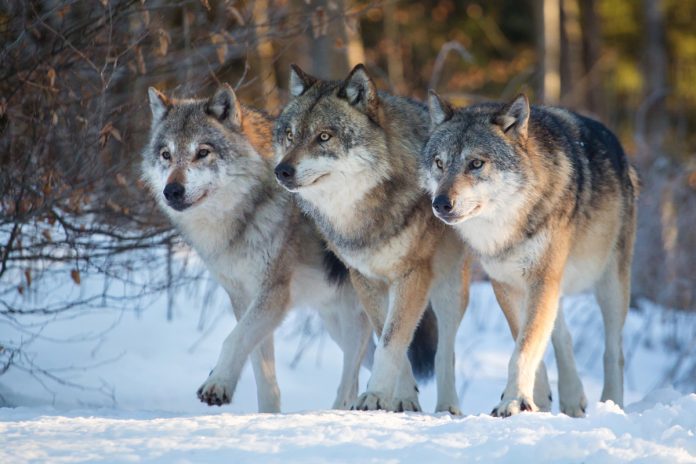Coexisting with carnivores can be a challenge, but their value makes it worthwhile, as Professor John Vucetich and Professor David Macdonald explain
The well-being of many human communities depends on healthy forests and grasslands. Those ecosystems can be degraded by over-browsing and over-grazing by large herbivores – moose, deer, elk, gazelles and so forth. That overconsumption is far less likely to occur when large herbivores are limited by healthy populations of large carnivore – wolves, lions, lynx, wolverine, bears, etc. Moreover, ecosystems with healthy populations of large carnivores tend to have greater levels of overall biodiversity. In a nutshell, and at risk of glossing over details, the conservation community has concluded that large carnivores have great ecological value.
Nevertheless, human communities often find it difficult to live near populations of large carnivores. Difficulties arise in three ways. First, carnivores kill domestic livestock, which provides for the well-being of some humans. Carnivores do not kill for malice; they do so because their well-being depends on it. Moreover, carnivores would naturally prey on wild animals. In many cases, however, the wild prey have been displaced by domestic livestock.
Second, carnivores kill wild prey that is also hunted by humans for subsistence or recreation. In this way, large carnivores are treated as competition to be eliminated.
Third, some species of large carnivores, on some occasions, threaten and take human lives. Important examples include human-eating lions in portions of Africa and human-eating tigers in portions of south Asia.
While these three elements of conflict are real, they are also frequently and grossly exaggerated. In the United States, for example, the impacts of wolves on livestock and hunting are very small and wolves do not pose a threat to human safety1. Yet, these concerns are an important fuel for wolf persecution.
Under threat
Genuine and perceived threats lead to humans killing carnivores at high rates through illegal poaching and legal culling and hunting. The result of all this killing is that two-thirds of the world’s carnivore species are threatened with extinction and most places do not have their native compliment of carnivores. The end point of treating this conflict – as humanity has thus far – is irreversible extinction and gross mistreatment of carnivores that manage to persist. An important element of this conflict concerns the received and oft-repeated motivation offered for why carnivores should be treated better: because they are ultimately of value to humans. The genuine wellbeing of humans is an important reason to conserve, but it is not the only one and alone it is inadequate.
European colonists and their descendants drove various large carnivores to extinction over a substantial portion of eastern North America. Britain drove its large carnivores – wolves, lynx and brown bears – to extinction centuries ago. It is difficult to mount a case that the wellbeing of those humans is worse as a result of those extinctions. When an object (think, carnivores) is valued only for its utility, its utility may go unrecognised, be outweighed by costs of maintaining it, or replaced by a substitute. This is not a denial of carnivores’ utility, but an acknowledgement of the risk in valuing something only for its utility. As such, nature’s utility is an (important, but) insufficient motivation for conservation.
Conserving carnivores
What if, carnivores are valuable, not only for advancing human wellbeing but also because they have a value in their own right? What if, we have an obligation to treat carnivores fairly and with at least some concern for their wellbeing? The response to those questions begins with the supposition that humans possess this kind of value and are entitled to this kind of treatment because we have interests (e.g., to avoid pain and to flourish). It follows that any entity with such interests would also possess this kind of value. Because all vertebrate organisms possess those interests, they also possess this kind of value and deserve this kind of treatment. The force and universality of this reasoning are indicated by the principle of ethical consistency, i.e., treat others as you would consent to be treated in the same position. Most human cultures are undergirded by some variant of this principle (e.g., golden rule). This intrinsic value of at least some non-human portions of nature is widely acknowledged – reflected by sociological evidence and many instances of laws and policies. Ethicists encapsulate these ideas by saying that carnivores (and many other forms of life) possess intrinsic value2.
Future success in carnivore conservation will depend, in part, on better understanding ideas that will foster effective and fair mitigation and adjudication of conflict, especially:
- The extent to which conservation can be achieved through protected areas and land-sparing, opposed to land sharing3;
- Mechanisms of socioeconomic behaviour that adversely impact carnivores. Some elements may be underappreciated (e.g., wealth inequality,4) and other elements may be favourable to conservation (e.g., tendency to increasingly embrace nature’s intrinsic value with increasing economic development,5);
- How to subsidise coexistence by compensating those adversely affected by living with carnivores. The challenge is tailoring compensation in ways that are fair and effective, yet do not foster, e.g., perverse incentives, additionality, or leakage6;
- How to best juxtapose the values of conservation and social justice in a manner that genuinely honours the intrinsic value of carnivores without being misanthropic7.
Conservation is no longer limited by ecological knowledge about carnivores’ ecological value or needs. Increasingly, the limiting factor is an effective application of knowledge arising from the synthesis of social sciences, social justice and conservation.
1 Vucetich (2016), Oversight Hearing, United States House Of Representatives. https://www.gpo.gov/fdsys/pkg/CHRG-114hhrg21616/pdf/CHRG-114hhrg21616.pdf
2 Vucetich et al. (2015), Conserv Biol, https://doi.org/10.1111/cobi.12464
3 Fischer et al. (2014), Conserv Biol, https://doi.org/10.1111/conl.12084
4 Holland et al. (2009), Conserv. Biol., https://doi.org/10.1111/j.1523-1739.2009.01207.x
5 Bruskotter, Vucetich, et al. (2017), BioScience, https://doi.org/10.1093/biosci/bix049
6 Dickman, Macdonald, & Macdonald (2011), Proc Natl Acad Sci, USA. https://doi.org/10.1073/pnas.1012972108
7 Vucetich & Nelson (2010), BioScience, https://doi.org/10.1525/bio.2010.60.7.9
Professor John A. Vucetich
School of Forest Resources and Environmental Science
Michigan Technological University
javuceti@mtu.edu
Professor David W. Macdonald
Wildlife Conservation Research Unit
The Recanati-Kaplan Centre, Department of Zoology
University of Oxford
david.macdonald@zoo.ox.ac.uk
Please note: this is a commercial profile











